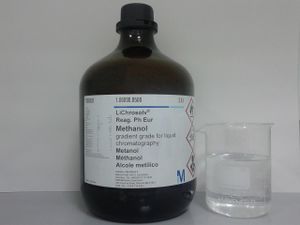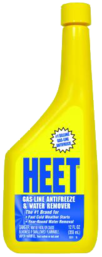Methanol
 Methanol sample and its original bottle.
| |
| Names | |
|---|---|
| IUPAC name
Methanol
| |
| Systematic IUPAC name
Methanol | |
| Other names
Carbinol, Columbian spirits, Hydroxymethane, Methyl alcohol, Methyl hydrate, Methyl hydroxide, Methylic alcohol, Methylol, Pyroligneous spirit, Wood alcohol, Wood naphtha, Wood spirit
| |
| Identifiers | |
| Jmol-3D images | Image |
| |
| Properties | |
| CH3OH CH4O | |
| Molar mass | 32.04 g/mol |
| Appearance | Colorless volatile liquid |
| Odor | Alcoholic |
| Density | 0.792 g/cm3 |
| Melting point | −97.6 °C (−143.7 °F; 175.6 K) |
| Boiling point | 64.7 °C (148.5 °F; 337.8 K) |
| Miscible | |
| Solubility | Miscible with ethanol |
| Vapor pressure | 13.02 kPa (at 20 °C) |
| Acidity (pKa) | 15.5 |
| Hazards | |
| Safety data sheet | ScienceLab |
| Flash point | 11 to 12 °C |
| Lethal dose or concentration (LD, LC): | |
| LD50 (Median dose)
|
5628 mg/kg (rat, oral) 7300 mg/kg (mouse, oral) 12880 mg/kg (rat, oral) 14200 mg/kg (rabbit, oral) |
| LC50 (Median concentration)
|
64,000 ppm (rat, 4 hr) |
| Related compounds | |
| Related compounds
|
Ethanol |
| Except where otherwise noted, data are given for materials in their standard state (at 25 °C [77 °F], 100 kPa). | |
| Infobox references | |
Methanol, or methyl alcohol is the simplest alcohol, with the formula CH3OH, also abbreviated as MeOH. It is a light, colorless, volatile, flammable liquid. It is an important chemical as a solvent and feedstock organic compound.[1]
Contents
Properties
Chemical
Methanol is a starting point for many organic compounds, such as formaldehyde, which is produced by oxidation of methanol. Methanol vapors in air will decompose over the course of several days to form carbon dioxide and water vapor.[2] Methanol is used in the production of biodiesel.
Physical
Methanol is a colorless, volatile, flammable liquid. It has a molecular weight of 32.04, a boiling point of 65°C and a density of 0.7914 g/cm3[3]. Methanol/water mixtures can be separated into two layers by salting-out with potassium carbonate.
Availability
A type of antifreeze and automotive cleaner known as Heet can be found in most gas stations in the United States and is 99% or higher methanol. Some alternative fuels are entirely or mostly made of methanol, and due to the large quantities typically sold this can be a very efficient way to purchase it. Methanol is sometimes sold at paint supply stores as wood alcohol, or methyl alcohol.[4] It can also be bought from scientific suppliers in higher grades. Hardware supplies sometimes sell methanol as "methyl hydrate" or "methylated spirits". Finally, some home fireplaces use methanol as fuel, so it can be found in this manner as well. Some window cleaning solutions contain up to 70% methanol, along with water and dye, as well traces of ethanol and or isopropanol.
In some countries the sale of "clean" (high purity) methanol may be regulated, due to its use in counterfeit alcohol.
Preparation
Impure methanol can be obtained via destructive distillation of wood. The process is not economically viable on a small scale, and produces many side products/contaminants, acetic acid, acetone, and tars among them. It is still an interesting process though, and could be attempted solely for educational value.[5]
Projects
- Make formaldehyde
- Make trimethyl borate
- Make methyl salicylate and other methyl esters
- Methyl iodide synthesis
- Dimethyl ether synthesis
- Direct methanol fuel cell
Handling
Safety
Methanol is significantly more toxic than other common alcohols such as ethanol or isopropanol, as it is metabolized to formic acid in the body, causing blindness and death at high doses.
Methanol flames tend to have extremely low visibility, particularly in the daytime or well-lit environments, making burning methanol difficult to detect and posing a great risk. If it is being used in instances where burning is likely, the addition of a small amount of boric acid colors the flame green and allows it to be seen.
One of the most insidious traits of methanol is that is is hard to distinguish from ethanol, they have a similar appearance, smell and taste. Accidentally consuming methanol may be lethal. In case if methanol is accidentally consumed, the first aid is giving the patient ethanol, orally, preferably in the form of vodka, until the state of "absolutely shit-faced", and then immediately calling the ambulance. Ethanol does not neutralize the effect of methanol but competes with it and prevents its immediate metabolism, giving the doctors more time to save the patient. If no medical attention is available, the only cure is continuously giving the patient ethanol until all methanol is purged from his organism unmetabolized. As a rule of thumb, three days of binge drinking forced upon the patient is enough to completely thwart methanol poisoning.
One urban, though not very accurate, way to detect methanol involves inserting a red-hot piece of copper wire into the alcohol. If vapors have a stinging smell like "morgue" or "dissected frogs" (the odor of formaldehyde), then the alcohol contains methanol, though this method is not very reliable, and is only effective at high concentrations.
Storage
Methanol is best kept in glass bottles in dark places. Methanol should be kept out of rooms with an open flame, as it is highly volatile and flammable. Methanol bottles should be clearly marked with the name of the compound, the "skull and crossbones" sign and a clarifying addendum "This is not ethanol, you moron!", especially in houses where drinkable ethanol is also kept.
Disposal
Burning methanol is a good way to destroy it. A good tip is to make the flame visible with some sort of salt and try not to burn too much at once, to prevent its vaporization in the air or inhalation of partial oxidation products such as formaldehyde, formic acid, or carbon monoxide.
References
- ↑ http://en.wikipedia.org/wiki/Methanol
- ↑ http://pubchem.ncbi.nlm.nih.gov/summary/summary.cgi?cid=887&loc=ec_rcs#itabs-2d
- ↑ CRC Handbook of Chemistry and Physics 66th Edition, 1985
- ↑ http://en.wikipedia.org/wiki/List_of_commonly_available_chemicals#L.E2.80.93N
- ↑ http://www.sciencemadness.org/talk/viewthread.php?tid=2652
Relevant Sciencemadness threads
- Methanol -> methanal(formaldehyde)
- Destructive Distillation of Wood
- Methanol Synthesis(Newer thread)
- Chemical pages without CAS Registry Number
- Articles without EBI source
- Chemical pages without ChemSpiderID
- Chemical pages without DrugBank identifier
- Articles without KEGG source
- Articles without InChI source
- Articles without UNII source
- Articles containing unverified chemical infoboxes
- Pages with broken file links
- Chemical compounds
- Organic compounds
- Alcohols
- Primary alcohols
- Solvents
- Polar solvents
- Amphiphilic solvents
- Volatile chemicals
- Neurotoxins
- Things that can kill you very quickly
- Liquids
